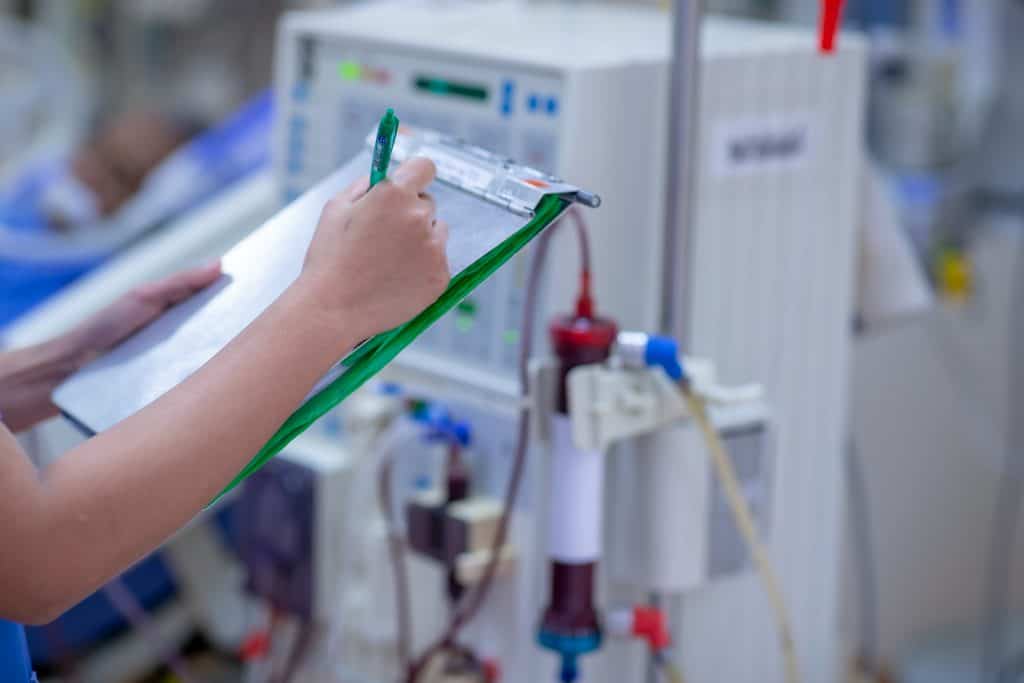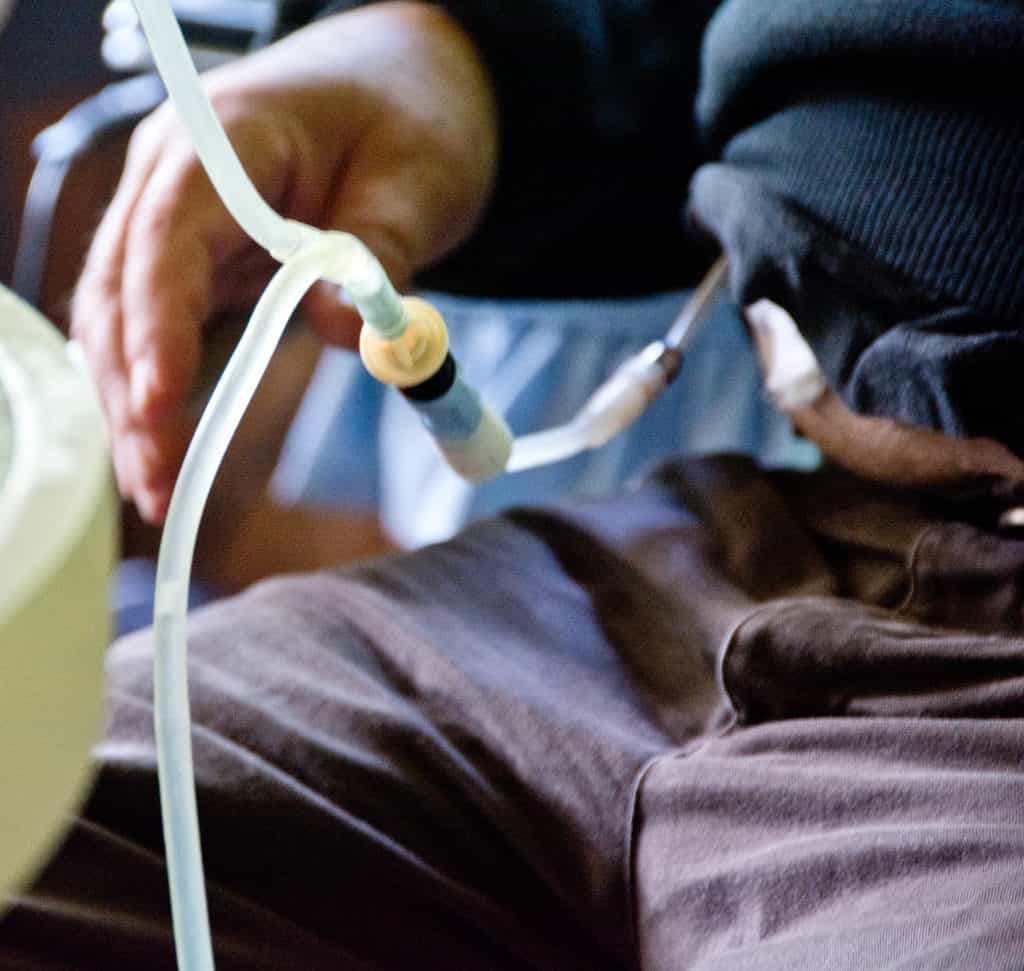When you’ve been diagnosed with chronic kidney disease (CKD), you and your health care provider will discuss treatment options to help manage your condition and prevent it from progressing to kidney failure. Treatment will depend on what stage of the disease and if there are any underlying causes, like diabetes or high blood pressure.
In the earlier stages of CKD, treatment options may include a modified diet, antihypertensive medications, and vitamins and supplements. As the disease progresses to end-stage renal disease or end-stage renal failure, the kidneys are no longer functioning and will require a more extreme treatment protocol. End-stage renal disease requires either dialysis or a kidney transplant.
What is Chronic Kidney Disease?
Chronic kidney disease is a gradual loss of kidney function over time. The kidneys are an important organ in the body that is responsible for filtering waste and excess fluids from the blood, maintaining overall fluid balance, and regulating the amount of salt and minerals in the body. Waste, excess fluid, and minerals are excreted through the urine to prevent buildup. But when kidneys become damaged, they aren’t able to filter blood as well as they should. This means that excess fluid, waste, and minerals can’t be removed properly and remain in the body.
When this happens, they build up in the body and can cause other health problems such as:
- Heart disease
- Stroke
- Anemia
- Higher risk of infection
- Imbalances in calcium, sodium, potassium, and phosphorus
- Depression
While nearly 37 million adults in the United States have chronic kidney disease, it’s called a silent disease because CKD symptoms don’t usually appear until later stages. Some signs that kidney function is declining include:
- Nausea and vomiting
- Fatigue and weakness
- Loss of appetite
- Sleep problems
- Changes in urination
- Edema
When symptoms become more severe, it’s likely to signal stage 3 or later of CKD. Once kidney disease has progressed to kidney failure, the only way to manage it is by dialysis or kidney transplant.
What is Dialysis?
End-stage renal failure is when renal function has dropped below 10-15%. At this stage, aggressive medical intervention is needed to prevent toxins from accumulating in the blood. If too many toxins accumulate organs can fail, which can lead to death in a matter of hours or weeks.
Dialysis is a treatment that manually filters the blood. It helps control the functions in the body in the same way that healthy kidneys would. In addition to removing waste and excess fluids from the blood, dialysis helps kidneys do other jobs like:
- Make red blood cells
- Help keep bones healthy
- Control blood pressure
While dialysis isn’t a cure for kidney failure, it can help people with failing kidneys live longer and more comfortably.
What Is The Dialysis Process Like?
Once you and your health care provider have determined that dialysis is the right treatment option for you, a surgeon will create an access point for the dialysis machine which creates a path between the machine and your blood. The access point can be a shunt in a vein or a catheter in the abdomen.
The type of access point determines the type of dialysis you receive. There are two primary types of dialysis called hemodialysis and peritoneal. Hemodialysis is performed through the vein in your arm. Peritoneal dialysis is through the abdominal cavity.
What Are the Different Types of Dialysis?
Hemodialysis and peritoneal dialysis are the two main types of dialysis.
Hemodialysis
Hemodialysis is one method by which waste, water, and minerals are filtered out of the blood. In hemodialysis, blood is pumped from the body through tubes connected to a vein and flows into a dialyzer machine, which filters the blood. Once filtered, it is then returned to the body through another set of tubes. During the filtering process, the dialyzer monitors your blood pressure and controls how quickly the blood is removed from the body and flows through the filter. This type of dialysis can be performed both in-home or in center.
In-center hemodialysis is the most common type of hemodialysis. At the center, a health care professional will help get you set up and connected to the dialysis machine. Treatments are usually 3 days per week and last about 4 hours. Because treatments are time-consuming, it’s important to choose a dialysis center closest to you, schedule appointments ahead of time, and consider any work and family-related responsibilities.
Some dialysis centers offer nighttime treatments. Nighttime treatments occur 3 nights per week while you sleep, but they take longer. Longer overnight dialysis treatments mean:
- Free days
- Fewer diet changes
- Higher liquid allowance
- Fewer symptoms of kidney disease
- Better quality of life than standard hemodialysis schedule
Home dialysis is the same as in-center dialysis, except you are the one performing your treatments. This means you are in charge of how long and frequent your treatment sessions are. Treatments range from 3 to 7 days per week and last anywhere from 2 to 10 hours. The three types of home hemodialysis are:
- Standard home dialysis: three days per week for 3-5 hours per session
- Short daily hemodialysis: five to seven days per week for 2-4 hours per session
- Nightly home hemodialysis: three to six evenings per week during sleep
If you and your doctor decide home hemodialysis is right for you, they will determine the type of hemodialysis you need. When you first begin home treatments, you may check in with your doctor a few times a month. Once you have become accustomed to the treatments and schedule, you will likely check in with your doctor only once per month.
While in-center hemodialysis is most common, studies have shown that patients who are on home hemodialysis dialysis (HHD) showed long-term patient survival compared to those on in-center hemodialysis (IHD) and peritoneal dialysis (PD).
One study examined a total of 152 patients on HHD and matched them with 608 IHD and 456 PD patients. The study took into account the age and comorbidities of patients. The median survival for HHD patients was 18.5 years, compared to 11.9 years for IHD patients and 15.0 for PD patients. Researchers also found that patients on HDD were more likely to receive a renal transplant compared to patients on other types of dialysis.
Peritoneal
In peritoneal dialysis, the inside lining of the stomach acts as a filter. Waste is removed by a cleansing fluid called dialysate, which is pumped onto the abdomen and left for a specific period of time. The fluid is then drained from the abdomen, measured to ensure it has all been collected, and then discarded.
There are 2 kinds of peritoneal dialysis:
- Continuous Ambulatory Peritoneal Dialysis (CAPD)
- Automated Peritoneal Dialysis (APD)
The treatment is the same for both types of peritoneal dialysis, but the number of treatments and the way they are performed differ.
CAPD is a continuous, machine-free method that works throughout the day. It starts by hooking up a bag of cleansing fluid into the tube in the belly. The total amount of cleansing fluid required for this method Is two quarts, so it may require more than one bag. Once the fluid is placed into the belly, it works to remove the waste from the blood and is then drained from the belly and disposed of. This process is usually performed 3-5 times in a 24-hour period. Each exchange of fluid usually takes about 30-40 minutes.
APD is different from CAPD because it is machine-driven. With APD, a machine called a cycler fills and empties the belly 3-5 times throughout the night. When you wake up in the morning, a fresh solution is in the belly and can be left all day. An exchange can also be done in the middle of the day without the machine. At the end of the day, before going to bed, a tube is hooked up from the machine to the catheter in the belly that cycles the fluid in and out throughout the night.
Many people will work with a nurse for a week or two to learn how to properly perform exchanges and avoid infection. It’s also helpful to bring a friend or family member to training in case you need help with exchanges. After training with the nurse, many are able to do the exchanges on their own.
A 2021 study found that adult patients of comparable characteristics on APD had a similar five-year survival rate as patients on home hemodialysis. Patients on APD had a five-year survival rate of 88%, whereas home hemodialysis patients had a 90% survival rate. The study also found that patients on CAPD had a five-year survival rate of only 56%.
What Are the Risks of Dialysis?
Dialysis is not a cure for kidney disease. While it is a treatment that can help improve quality of life, there are some risks and complications associated with the treatment. Many are related to the access site that makes dialysis possible. Others are caused by an imbalance of fluids and electrolytes, and impact blood pressure and heart function.
Some risks and complications include:
- Access site infection
- Access site clotting or scarring
- Muscle cramps
- Electrolyte abnormalities
- Increased fatigue around treatment sessions
- Hypotension
- Blood loss
- Hernia
- Changes in weight
To prevent any complications of dialysis, it’s important to work closely with professionals on your health care team. By knowing the possible risks and symptoms, you are better prepared for what to look out for should you notice something out of the ordinary. If you do notice symptoms like redness or swelling around the access site, fatigue, nausea, vomiting, or cramps, tell your health care providers right away so they can treat any complications.
For patients who are older in age or have other serious comorbidities like heart failure or cancer, dialysis may not be the right option. It’s important to consult with your health care team to determine if dialysis is the best option or if it is safer to wait for a kidney transplant.
Connect With Chronic Kidney Disease Patients
Living with chronic kidney disease can be difficult, especially when facing kidney failure. It means making extreme changes to your life, like your diet, fluid intake, and treatment protocol. Sometimes it may even feel like you are all alone in your condition. PatientsLikeMe is here to support you at every step of your CKD journey. Connect with other patients who understand what you are going through and can provide you with the support you need as you navigate your kidney disease treatment.



